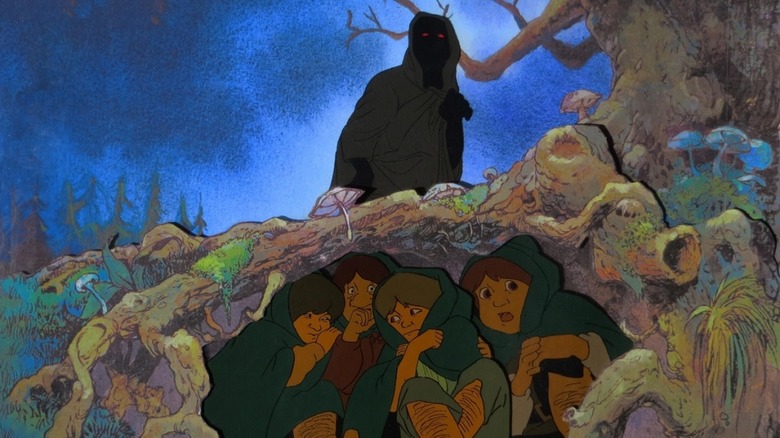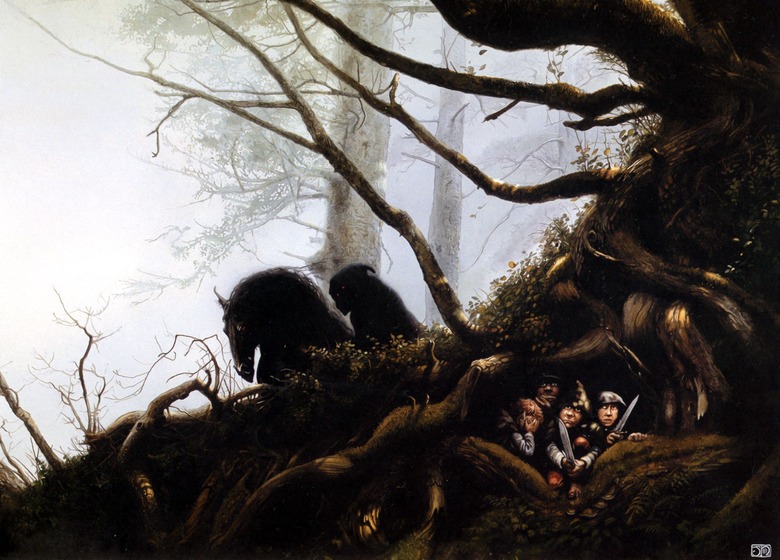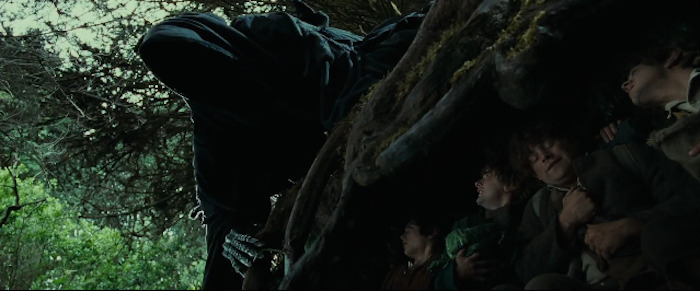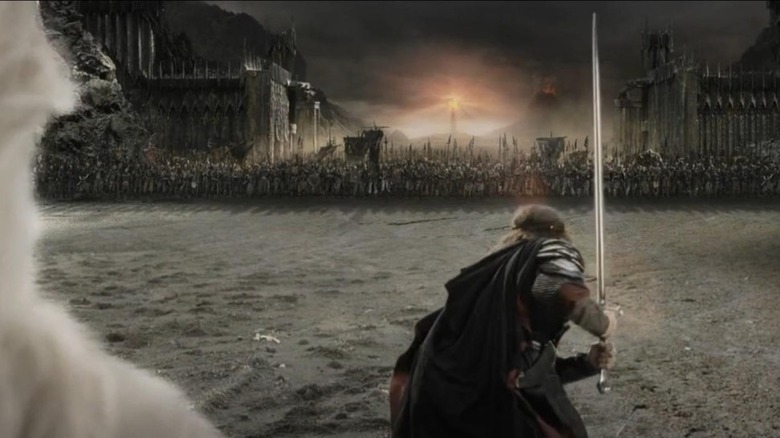Alternate Histories: The Two Film Adaptations Of 'Lord Of The Rings' On Their 40th And 15th Anniversaries
2018 is a major anniversary for The Lord of the Rings on screen. It's been 40 years since the release of Ralph Bakshi's animated version, and 15 years since the completion of Peter Jackson's live-action trilogy. This dual anniversary – in addition to an imminent new adaptation on Amazon – makes for a fine opportunity to look at the two versions that exist so far. How do they differ? How do they align? Looking back at both from a distance, the answers surprised even me.
A Halfling Half-Movie
Ralph Bakshi was a strange choice to direct The Lord of the Rings. Most of his career was built up of wildly transgressive films sharing borders with exploitation cinema. His wildly successful debut Fritz the Cat proudly proclaimed its "X" rating on its poster; Heavy Traffic promised "more spice" than even that; Coonskin's racially-charged content can be seen in its very title. Bakshi signaled a career shift, however, with his 1977 post-apocalyptic fantasy Wizards, which sought to demonstrate the director could work in a family-friendly milieu. The film was a success, and as his followup, Bakshi approached Tolkien rights-holder and One Flew Over the Cuckoo's Nest producer Saul Zaentz about adapting The Lord of the Rings.Produced using a variety of techniques, Bakshi's film strikes an old-fashioned tone. It leans hard into the fantastical, depicting the hobbits as jolly, round-faced caricatures. The taller characters, largely rotoscoped over live-action guide footage, bear a more realistic appearance, but are costumed as if from a Halloween pop-up shop. Bakshi later regretted using the rotoscoping process, which more or less amounted to tracing, and the film's solarised live-action elements stick out from the rest of the film like a sore thumb. This mixed-media approach – cel animation, rotoscoping, filtered live-action – reflects the ambition of the project, but ends up creating a distancing effect. You become all too aware of the techniques, as compared with, say, a fully cel-animated film.Bakshi's narrative approach was simple. He aimed to hew as closely to the book's narrative as possible, as a promise to Tolkien's daughter, making a few cuts but generally sticking with the original story and even dialogue. Parts of Frodo's journey to Rivendell have been cut, since the story doesn't truly kick in until he reaches the Elven city. Saruman was renamed "Aruman" (in certain scenes, at least – it's inconsistent) in an attempt to avoid confusion with Sauron. But generally speaking, it's pretty faithful to the book, albeit hastened to fit a two-hour running time.Unfortunately, Bakshi's Lord of the Rings was left as an incomplete adaptation. Originally intended as a two-film project, the released film covers the events of The Fellowship of the Ring, and early parts of The Two Towers, culminating in the battle of Helm's Deep. And then...it ends. United Artists didn't market the film as the first of two parts, and refused to fund a sequel even when the film became a box office success. Bakshi was furious about the entire process, and no one was left satisfied.
The In-Betweeners
Curiously, a sequel of sorts did emerge, from a completely different source. Rankin-Bass, best known for its stop-motion Christmas specials, produced a TV movie in 1980 titled, unexpectedly, The Return of the King. Though technically a sequel to its earlier adaptation of The Hobbit, it was also positioned as an unofficial sequel to The Lord of the Rings. They don't line up particularly well: the animation styles are completely different, it's heavy on sung narration, and the latter parts of The Two Towers are left untold. This, in addition to the fact that Gimli, Legolas, Saruman, and Arwen aren't in the film at all! Christopher Lee would be furious.Clearly, the field was wide open for a definitive adaptation of Tolkien's magnum opus. Many had tried before. Forrest J. Ackerman pitched one in the '50s. In the '60s, the Beatles wanted to cast Paul, Ringo, George, and John as Frodo, Sam, Gandalf, and Gollum, respectively. The film version that got closest to production came from Deliverance's John Boorman, whose lengthy screenplay took extreme liberties: it eliminated Faramir, the Ents, Isengard, Helm's Deep, and all flying creatures; hobbits lived in cottages, not holes; and Frodo had mystical sex with Galadriel.Generally speaking, the sheer scale of the undertaking was always deemed unachievable – even Stanley Kubrick considered the book's scope unfilmable. It wasn't until the late 1990s that Peter Jackson would make his bid for a live-action adaptation, to be filmed in New Zealand.
The Lord of the Lord of the Rings
Peter Jackson's original pitch was far more humble than what ended up on screen. Originally at Miramax, the adaptation would have spanned only two movies, later slashed to one by the now-disgraced Harvey Weinstein. It was at that point that Jackson and his cowriters shopped their project around, finding support at New Line Cinema, where founder Bob Shaye suggested making three films instead of two. Though a decision made for economic reasons (shooting three movies at once, with three sets of box office takings, is more cost-effective than shooting two), the call worked out for the filmmakers, who proceeded to greatly expand upon their original treatment.Jackson's adaptation was much darker, more grown-up, and above all more realistic than Bakshi's. Obviously, live action grants greater verisimilitude than animation to begin with, but the films also play heavily into Jackson's fascination with violence, monsters, and evil. There's plenty of beauty in the trilogy, of course: the world of the Elves is ornate and ethereal, that of Men grand and noble, and that of Hobbits rustic and charming. The laid-back lifestyle of hobbits bears similarities to a certain rustic ideal of the New Zealand lifestyle, and it's unsurprising that the frequently-barefoot Jackson absolutely nailed it. It also helps that in New Zealand, Jackson had an unparalleled set of locations in which to make his Middle-Earth feel like a real, living place.But though the hobbit scenes are laced through with down-to-earth good humour, and the elven scenes radiate beauty and light, Jackson simply doesn't seem to have as much fun with them as with the more sinister elements of the films. One need only watch the cinematography in scenes featuring orcs, Saruman, or Gollum: Jackson gets up close to the action, often with handheld cameras – "mucking in," as Kiwis say. You can feel the director's visceral delight in every closeup of a uniquely disgusting orc, and in every minor-key moment of dark melodrama. A living place, after all, also has to be a dying place.Initially, Jackson's films were excoriated by harder-core fans for their supposed unfaithfulness to the text. But in the grand scheme of things, Jackson's adaptations actually follow the source material pretty closely, and what changes were made were generally for the better. Omissions like Tom Bombadil and the Scouring of the Shire sparked controversy, but would have killed the films' pacing and/or tonal consistency. Some characters were altered to give them more interesting character arcs, as with Faramir, or to expand their roles, as with Arwen. The biggest alterations, though, are purely structural: where the books tell large chunks of one character's story then jump back to tell another's, Jackson's films cut between stories chronologically, creating more suspense and keeping all characters involved at all times.Many omissions were later restored in the films' Extended Editions, prompting many fans to accept them as the "true" versions of the films. These edits, however, while more "complete," aren't director's cuts, and there's a reason: they're not as good as the theatrical cuts, with many scenes disrupting pacing or dramatic suspense. They weren't created to make better films; they were created to provide a bounty of goodies for fans and completionists. It comes down to taste, but Jackson stated from the outset that the theatrical cuts are "his" cuts.In the end, Jackson's films became all-time classics, winning Oscars and breaking box office records. Despite nit-pickers' issues with the adaptation, they should count themselves lucky they didn't get the original two-film version – which at one point, would have merged Arwen and Eowyn and cut Lothlorien entirely – or even worse, Weinstein's one-film treatment, which would have gone further, merging Gondor and Rohan and cutting Saruman and Helm's Deep. Sometimes fans don't know how lucky they are.Interestingly, Jackson's adaptation took a number of cues from the Bakshi version. The films' prologues are nearly identical in both script and structure, and Bilbo's birthday party has many of the same shot setups in both versions. Tom Bombadil was removed from both versions due to stopping the story dead in its tracks, and most of the cuts from that first stretch of the story are identical in both versions. And of course, many scenes are staged similarly, as an inevitability of coming from the same source material.Most interestingly, one particular scene appears in both movies that never appeared in the book at all. The iconic shot of the four hobbits hiding from the Nazgul huddled under a tree root was actually invented by Bakshi, then re-painted by Tolkien illustrator (later a concept artist for Jackson) John Howe in 1985, before making its way into Jackson's film. The scene amalgamates several elements from the book, but as noted by Howe, it doesn't exist in the original text – at least, not in that particular configuration. It's an interesting quirk of inspiration, tying two disparate versions of a story together through a concept artist.
Legacy of the Rings
On paper, Bakshi's and Jackson's Lords of the Rings seem worlds apart. But aside from visual treatment, they're more similar than many would think. We'll never get to see what Bakshi's second film would have looked like, or how he would have treated the book's sprawling climax and denouement. We'll also, tragically, never truly know how a Beatles version would play out. John Lennon as Gollum is among the stranger ideas one can, shall we say, imagine. Ho ho ho.Right now, Amazon is developing yet another adaptation of Tolkien's world, costing a billion dollars (Jackson's films, factoring in inflation, would come to less than half that) and set to stream on Amazon Prime. The most expensive television project in history, it promises to be the most comprehensive Tolkien adaptation yet. Instead of simply adapting The Lord of the Rings, it will draw on a wide range of other Tolkien writings, potentially offering years of high-end fantasy programming for the streaming service. As a result, it'll be a vastly different beast to its predecessors.How will fans react to Amazon's wide-spectrum adaptation? Will they welcome the more-detailed fictional history? Or will they, somewhat ironically, react negatively if it strays too far from Jackson's venerated take on the property? The future is nothing if not fascinating – but regardless of how it goes, we'll always have the past.




